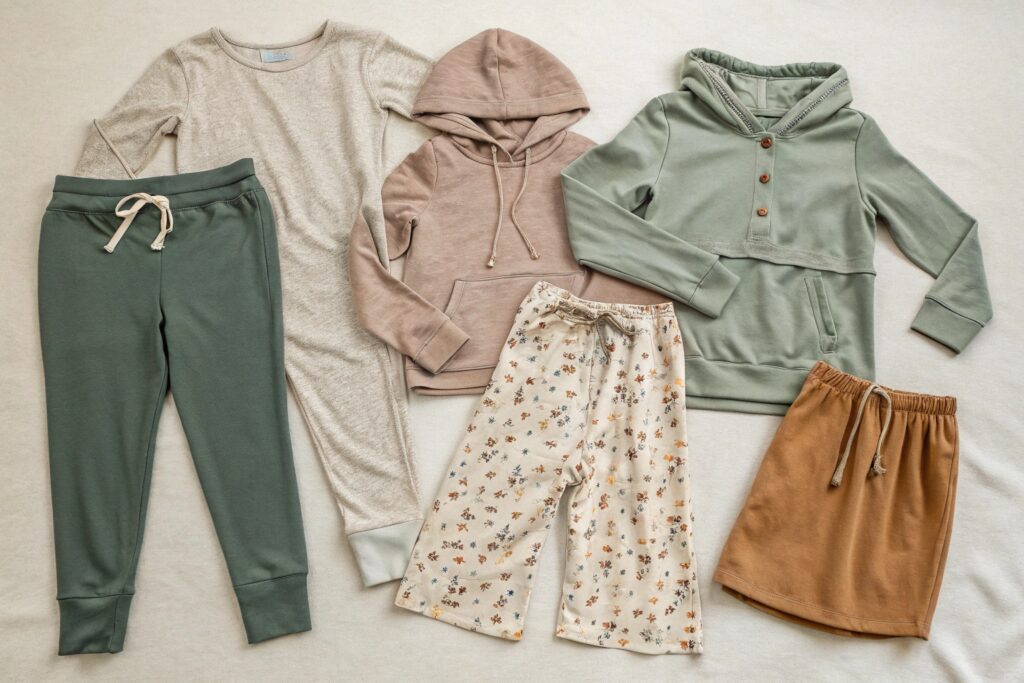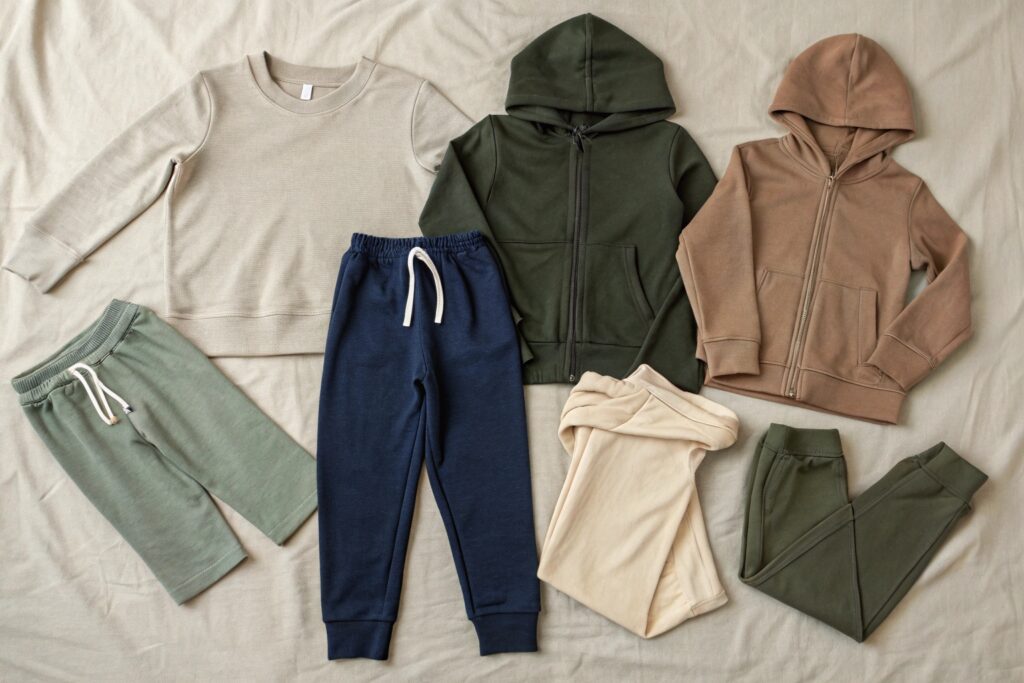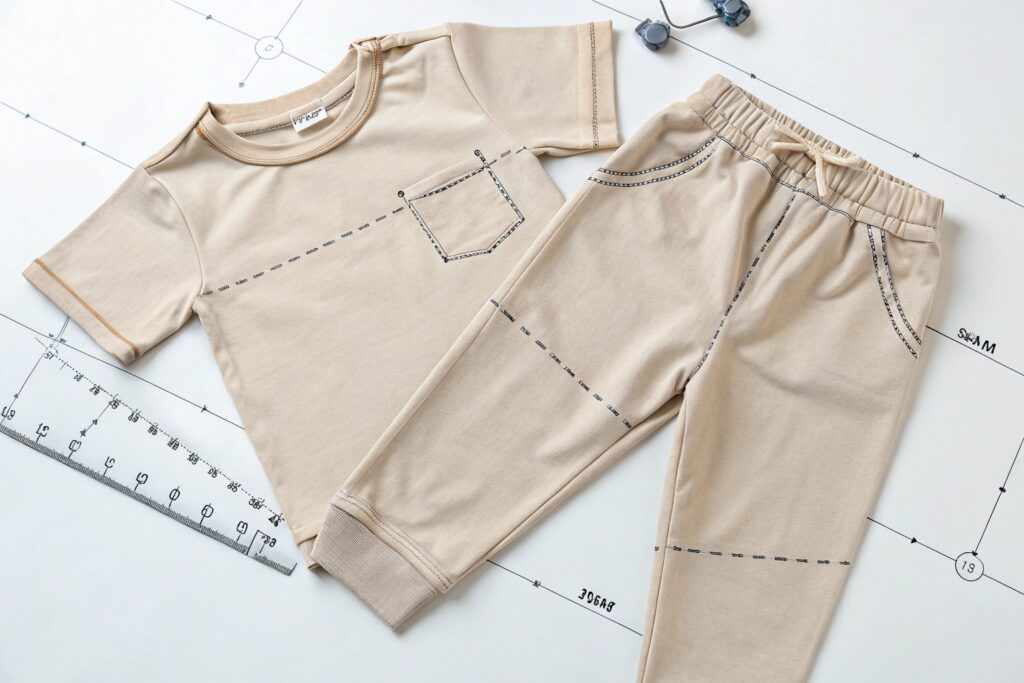Launching a kidswear capsule is exciting—but getting the sizing right is critical. One wrong call, and you’ll face returns, deadstock, or frustrated parents.
A successful kidswear capsule launch must offer a strategic size range based on target age group, fit flexibility, and regional growth curves.
In my work with global kidswear brands, I’ve learned that launching a capsule isn’t just about style—it’s about size accuracy and smart planning. Here’s everything you need to know.
What should be included in a capsule wardrobe?
Capsules are about doing more with less. For kids, that means focusing on comfort, durability, and coordination.
A kids’ capsule wardrobe should include a balanced set of tops, bottoms, layers, and one or two versatile extras that can mix and match seamlessly.

What Core Items Make Up a Kidswear Capsule?
We usually recommend these categories in a starter capsule:
| Category | Number of Pieces | Function |
|---|---|---|
| Tops | 3 | Variety in style and sleeve length |
| Bottoms | 2 | At least one jogger or stretchy pant |
| Layers | 1–2 | Cardigan, hoodie, zip-up |
| One-piece/Extra | 1 | Tunic, dress, or romper |
With 7–8 pieces, you can create 14–20 outfits when colors and fabrics are chosen correctly. That’s the power of capsule logic.
We help clients build “capsule-ready kits” that launch with curated combinations. These often become their bestsellers—especially in back-to-school or seasonal campaigns.
Should Sizing Affect the Item Types You Include?
Absolutely. For example, bodysuits and footed leggings are essential in infant capsules. But for older kids, more structured tops and layering pieces matter more.
Capsule content should match both the developmental needs and sizing expectations of your audience.
What is a basic capsule wardrobe for kids?
A basic kids capsule doesn’t need to be elaborate—it just needs to be functional, flexible, and future-friendly.
The basic kids capsule includes essential pieces that work across settings, seasons, and age transitions with minimal wardrobe waste.

What’s the Structure of a Minimal Kidswear Capsule?
Here’s our standard 7-piece model for clients launching kidswear lines:
- 2 x Tops (one solid, one printed)
- 2 x Bottoms (joggers + skirt or shorts)
- 1 x Layer (hoodie or cardigan)
- 1 x Wildcard (tunic, romper, or dress)
- 1 x Base Layer (long sleeve or fitted tee)
This basic layout gives:
- Weekday outfit coverage
- Weekend wear
- School-ready options
- Room to layer for weather changes
It also lets you cover multiple looks without overwhelming parents.
What Sizes Should Be Included in a Basic Launch?
Start by focusing on your core demographic. Are you targeting toddlers, school-age kids, or preteens?
Common capsule size packs:
| Age Range | Suggested Sizes |
|---|---|
| Infant | 0–3M, 3–6M, 6–9M, 9–12M |
| Toddler | 12–18M, 18–24M, 2T, 3T, 4T |
| Preschool | 4T, 5T, 6, 6X |
| School Age | 6, 7, 8, 10, 12 |
| Preteen | 10, 12, 14, 16 |
We recommend dual-size brackets (e.g., 2–3Y, 4–5Y) for flexible fit and lower inventory risk. This also simplifies buyer decisions.
How to measure children’s clothing size?
Sizing errors are the number one cause of online returns in kidswear. But they’re avoidable.
To measure kids correctly, use standard garment measurements across chest, waist, hip, inseam, and height—then apply them to age-based sizing charts.

What Are the Key Body Measurements for Children’s Apparel?
Here’s what we use in our production fit process:
| Measurement Area | How to Measure |
|---|---|
| Chest | Fullest part, under arms, flat back |
| Waist | Natural waistline, not too tight |
| Hip | Around the fullest point of hips/buttocks |
| Inseam | From crotch to ankle |
| Height | From top of head to floor |
We advise offering a size guide with visuals for all product listings—especially for capsules. Add tips like:
“If between sizes, size up for growth.”
How Do You Translate Measurements into Size Categories?
At Fumao, we align with international sizing standards based on height and weight correlations. For example:
- 2T = 33–35 inches, 27–30 lbs
- 5 = 41–44 inches, 38–42 lbs
- 10 = 52–55 inches, 70–75 lbs
We also provide custom grading for clients who export to multiple regions (US, EU, UK). Capsule lines especially benefit from this flexibility, as they are often marketed globally.
What is the ideal size for a capsule wardrobe?
It’s not just about garment size—but how many pieces to offer, and in what size range.
The ideal size offering in a capsule wardrobe launch includes dual or grouped sizing and focuses on the top-performing brackets for your target age group.

How Many Sizes Should You Offer in a Capsule Launch?
We suggest starting with 4–6 size options per age category. For example:
Toddler Capsule Launch:
Offer sizes: 18–24M, 2T, 3T, 4T, 5T
School-Age Capsule Launch:
Offer sizes: 5, 6, 7, 8, 10
Avoid overextending with too many SKUs. Instead, use flex-fit features like:
- Adjustable waistbands
- Extra stretch panels
- Foldable cuffs or extendable hems
These help buyers feel more confident—and reduce your return rates.
How Should You Structure Your Size Runs for Wholesale Buyers?
We help clients set pre-packs by size with common quantity ratios like:
- 1:2:2:1 (Small:Med:Med:Large)
- 1:1:1:1 (Even distribution for testing)
- 2:3:3:2 (For more popular mid-sizes)
You can also label packs by stage, like:
- "Toddler Trio Set: 2T, 3T, 4T"
- "School Starter Kit: 5, 6, 7"
These pre-packs simplify ordering and make wholesale more attractive for distributors.
Smart sizing = smoother sales + happier customers.
Conclusion
Launching a kidswear capsule isn’t just about style—it’s about smart sizing. With age-appropriate measurements, core wardrobe planning, and focused size runs, you can reduce risk and increase satisfaction. At Fumao Clothing, we help brands launch capsules that fit—every age, every time.










